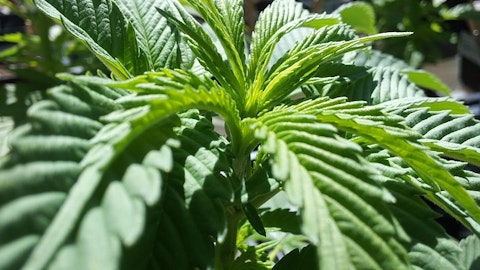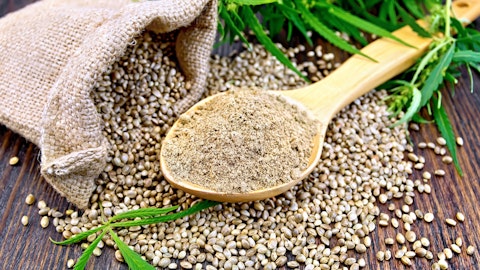So, I’m real optimistic, and I come back and I say this here, yes, the beer industry has gone through some challenges in growth. I think — and again, spending time with BCG and doing our studies here, I feel there is some great opportunities within the beer category. Now there has to be changes on alcohol. There has to be changes in regards to non-alcoholic. There’s got to be some other changes in how do we get males and females in Gen Z drinking beer is a lot of the stuff that we’re going to do. And we’ve talked about it. We’re going to expand into some water business, energy drink business and some other categories. We’re not going to be just the beer business. We will be the Tilray beverage business, I think which is important because we have manufacturing facilities, we have distribution out there and we have a sales and marketing infrastructure to drive this behind it.
And I got to tell you, there’s a tremendous amount of sporting venues. There’s tremendous amount of universities that have reached out to us and want us a part of their sponsorship.
Michael Lavery: Okay. Thanks so much.
Irwin Simon: Thank you.
Operator: The next question is from the line of Frederico Gomes with ATB Capital Markets. Please proceed with your question.
Frederico Gomes: Hi, good morning. My question is…
Irwin Simon: Good morning.
Frederico Gomes: …you mentioned key strategic acquisitions in your prepared remarks, something you look at. So, can you remind us how you look at acquisitions between your alcohol and your cannabis segments, and also geographically, whether you’re focused on Canada, the West, or are you also looking at opportunities elsewhere? Thank you.
Irwin Simon: So, I come back and look at strategic acquisitions, as I’ve said, we got a lot of growth, we got a lot of brands. We’re into most categories in the Canadian market. And with that, if there was something strategic that could help our cost structure that would help us to take — to be within our portfolio of brands, we would absolutely look at it. But you heard what I said before, one of the big things I’m looking at in Canada today, how do we diversify and be in other categories with adjacencies to the cannabis industry, and is that bev alcohol, is that drinks, et cetera. So that’s what we’re looking at in the Canadian market. In regards to the U.S. market, we’re focused on bev alcohol here. We’re focused on in regards to our Manitoba Harvest, is there food businesses with adjacencies that would make sense to be part of our Manitoba Harvest business, is something that we would look at.
And then internationally, we like the bev alcohol business internationally. There is some stuff that we’ve looked at there. And how do we expand some of our medical business in our international market, and there’s markets where we could do an acquisition or two. So, we’re looking at strategic. They got to be accretive. They got to be good value there for us and how do we integrate it into our current infrastructure. If you come back and look with the Tilray-Aphria acquisition, we took out over $100 million of cost. With the HEXO business, we’ll take out close to $35 million of cost. With Truss and our beverage business, we will take out additional costs there. If you come back and look at the ABI, SweetWater, Montauk, we will take a good amount of cost out of there.
So, what got to be is businesses that fit within where we can take out costs. But the more important thing here is we need organic growth and ultimately use that infrastructure. And as a company today of our size, I mean, just being a public company cost out there today, it’s higher costs for our insurance because we have cannabis within here. So again, how do we absorb some of those costs with putting more sales on, I think that’s something that we look at here.
Frederico Gomes: Thank you very much.
Operator: Our next question is from the line of Vivien Azer with TD Cowen. Please proceed with your question.
Robin Holby: Good morning. This is Robin Holby on for Vivien Azer, and thank you for taking the question. I just wanted to follow-up on the international question, specifically on Australia, where we’ve been seeing some strong patient growth. Any updates for your plans in that market? And do you see any of these international markets becoming saturated as more competitors achieve the necessary certifications? Thank you.
Denise Faltischek: Yeah. No, thank you for the question. So, in terms of Australia, we see really great opportunity in Australia. We have a more of — a leading business there in both Australia and New Zealand, both with our extracts as well as our flower. What we have done is we have expanded our portfolio of flower in order to take advantage of that market, including as of last quarter, we introduced Broken Coast into the market as the market really was looking for more of a proliferation around medical cannabis flower. And we will continue to evaluate that market for new form factors. In terms of your question about competition achieving more certifications, we have been in the market with GMP certification. Our GMP certification is actually above the standards that’s actually required in Australia.
And we find that healthcare professionals and government regulators enjoy the fact that we take the higher standard approach, considering that medical cannabis we think high standards as our key. And we will continue to grow that market and look for opportunities to partner with additional cannabis dispensaries, partnering with healthcare clinics, et cetera.
Robin Holby: Got it. Thank you.
Irwin Simon: Thank you.
Operator: Thank you. At this time, we’ve come to the end of our question-and-answer session. And I’ll hand the floor to management for closing remarks.





